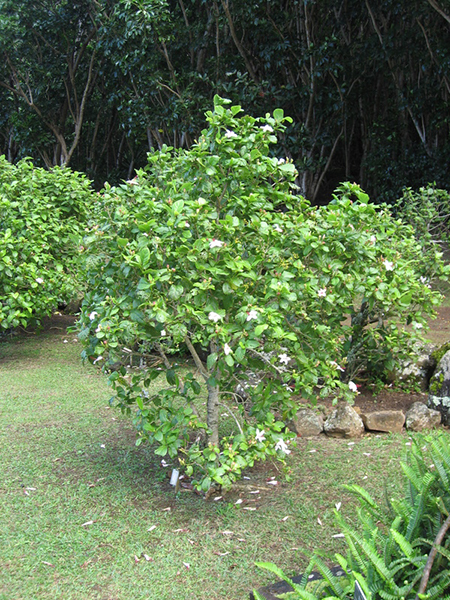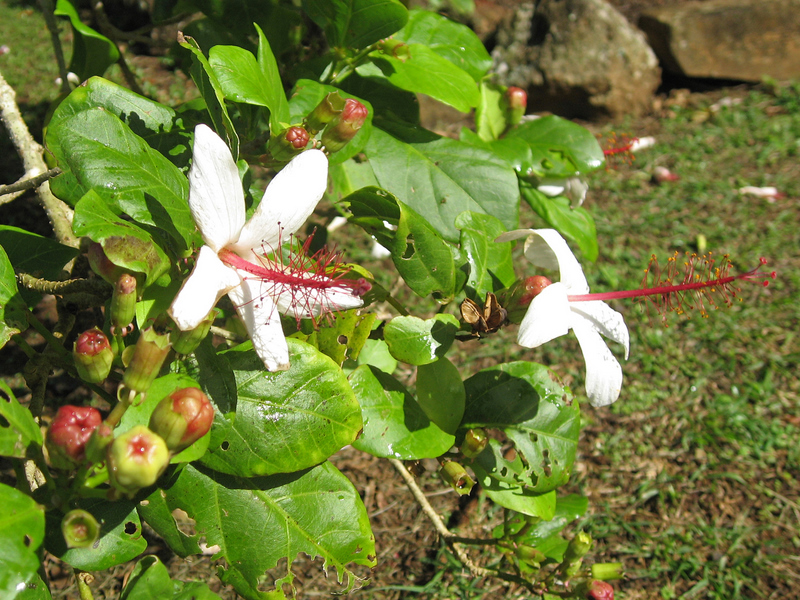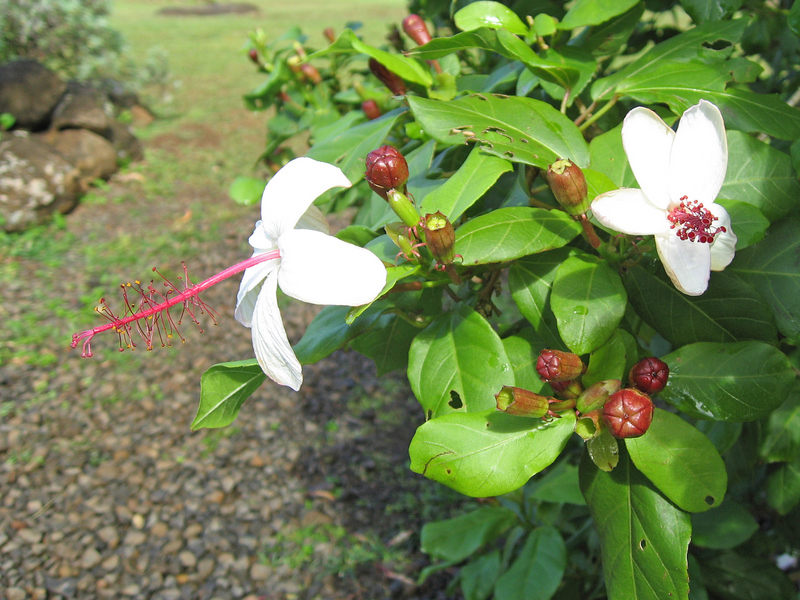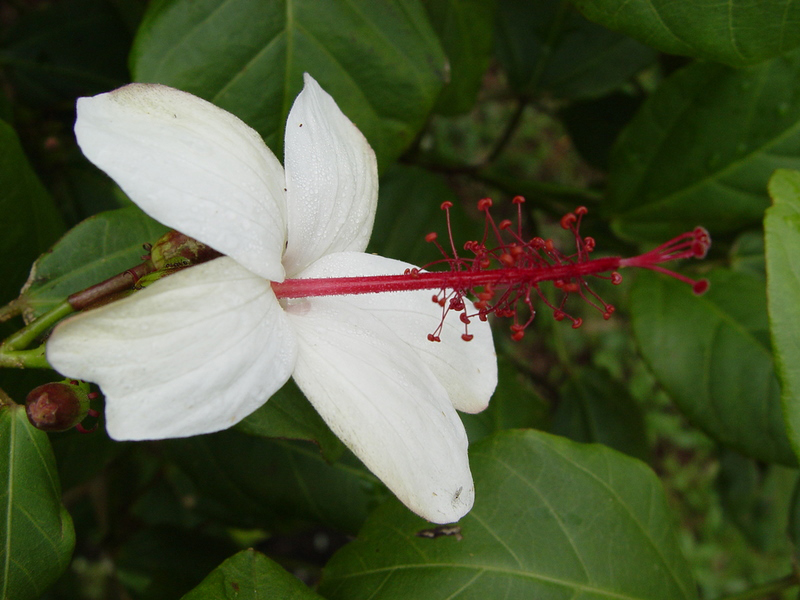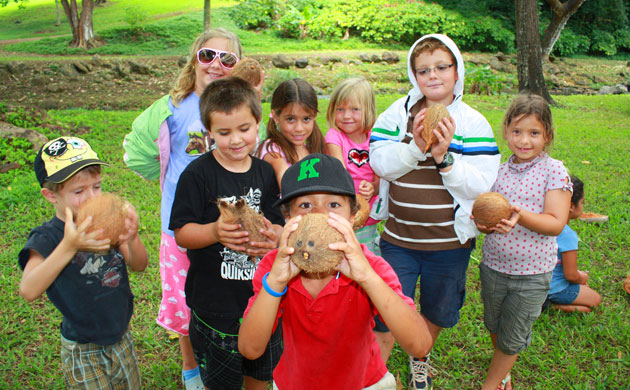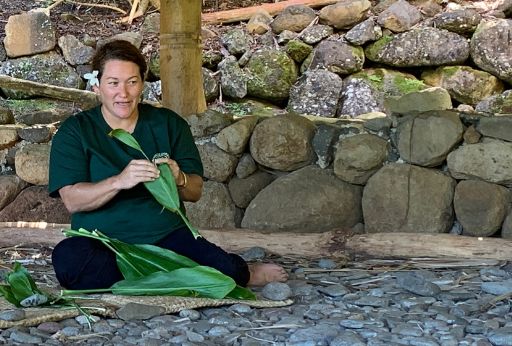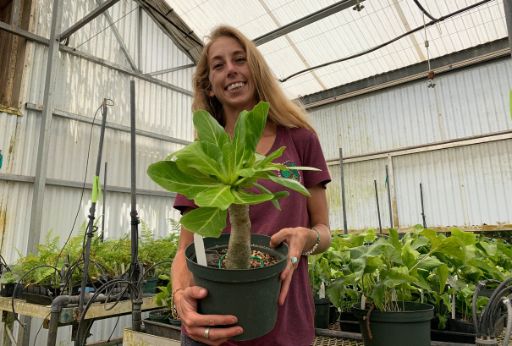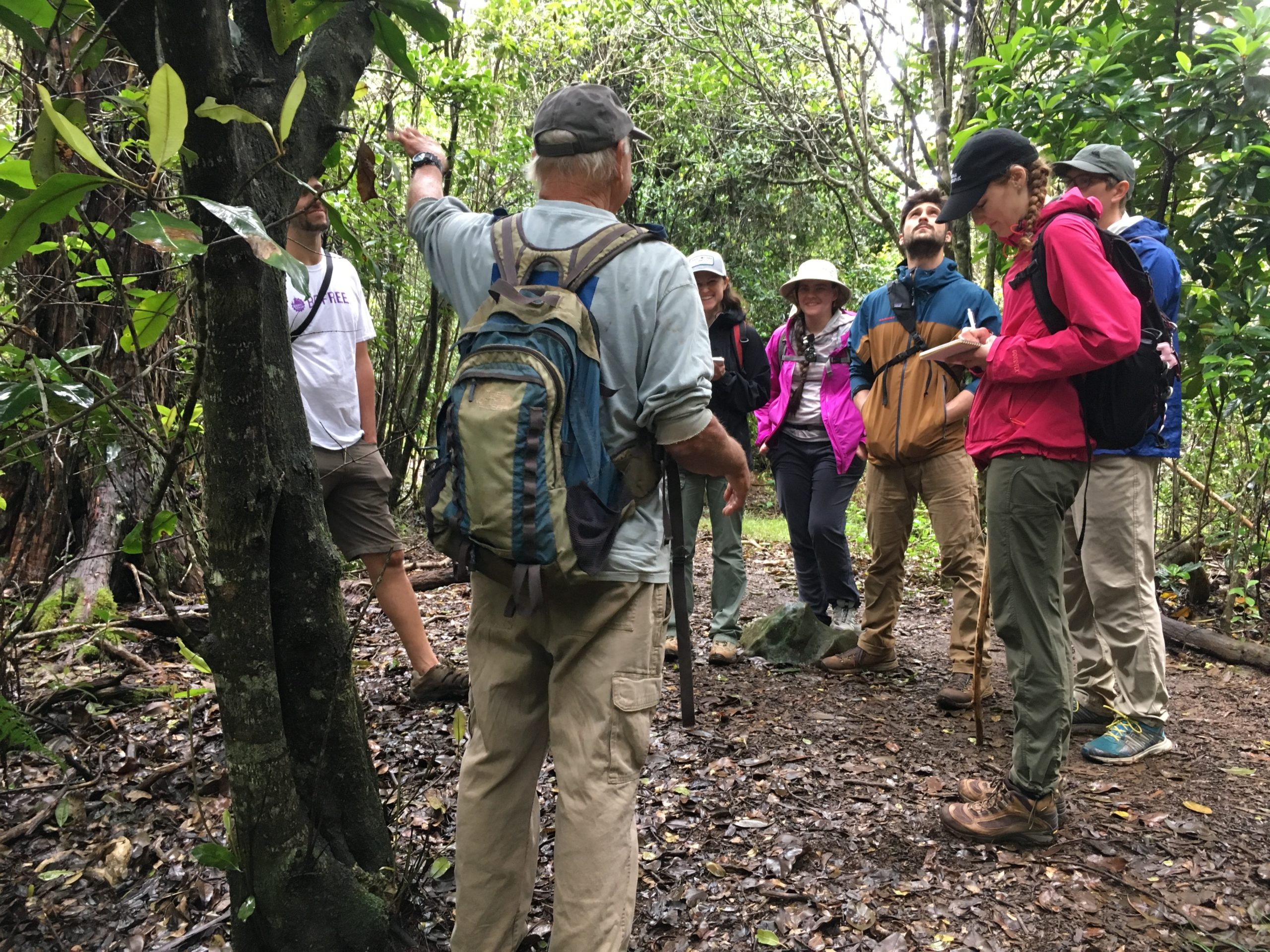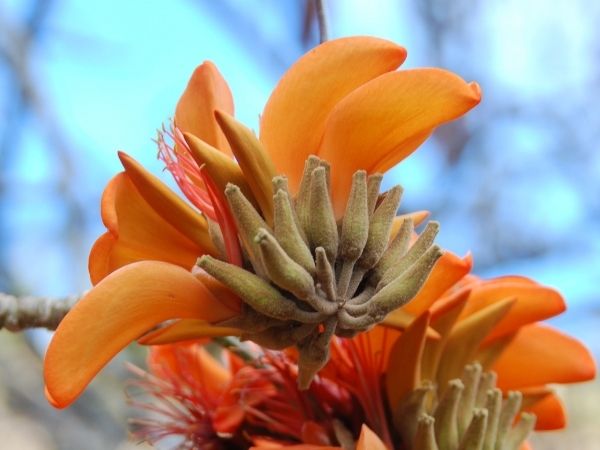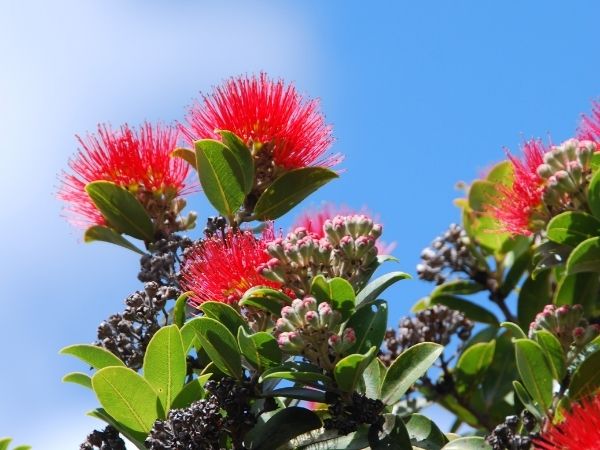Tropical Plant Database - Plant Details
Hibiscus waimeae subsp. hannerae
Conservation Status
- IUCN: Not Evaluated
- USFWS: Endangered
Genus: Hibiscus
Species: waimeae
Species Author: A. Heller
Subspecies: hannerae
Subspecies Author: (O. Deg. & I. Deg.) D. M. Bates
Vernacular: Koki`o ke`oke`o, koki`o kea
A member of the Mallow family (Malvaceae), Hibiscus waimeae subspecies hannerae (Koki'o ke'oke'o in Hawaiian) is a small, gray-barked tree up to 10 m tall. The upper surface of the leaves is light green while the lower surface is covered with velvety hairs which makes it appear grayish. The round or oval leaves are 5-20 cm long and 2 to 13 cm wide. The single flowers last only one day. They are white when they open in the morning and they fade to pink in the afternoon. The flowers occur towards the ends of the branches and have a strong, sweet fragrance, which is rare in the Mallow family. The staminal column is pink to crimson. The seeds of Hibiscus waimeae are contained in tough, oval capsules about 2 cm long. The fuzzy brown seeds are about 5 mm long. Hibiscus waimeae subsp. hannerae is easily grown from fresh seed, but Hawaiian hibiscus hybridize readily and seedlings may be very different from the parent plants. Of the two subspecies, Hibiscus waimeae subsp. hannerae has larger leaves, but smaller flowers than that of H. waimeae subsp. waimeae. (Wagner,W.L., D.R. Herbst, and S.H. Sohmer. 1990. Manual of the Flowering Plants of Hawaii.)(NTBG. 1992. Unpublished Internal Papers.)(Rauch. 1997.)
As efforts of preserving this subspecies pure, the National Tropical Botanical Garden on Kaua'i is propagating this rare Hibiscus by seeds and cuttings. To ensure that the seedlings are not hybrids, the dedicated people of NTBG hand pollinate the flowers. (National Tropical Botanical Garden. 1992. 1989. Unpublished Internal Papers.)
In old Hawai'i, Koki'o ke'oke'o were used primarily for decoration. People planted the shrubs close to their thatched huts and picked their flowers for ornament. Koki'o ke'oke'o grows well in cultivation. Around 1900 the Kaua'i species was recognized as a plant worthy of world-wide recognition. Seeds were sent to other tropical regions such as Florida and the West Indies, where it now brightens gardens as an "exotic, introduced" hibiscus. (Kepler, Angela K. 1984. Hawaiian Heritage Plants.) (Information for this species compiled and recorded by Camelia Cirnaru, NTBG Consultant.)
Hibiscus waimeae subsp. hannerae is rare and occurs only in Kaua'i's northwestern valleys of Hanakapi'ai, Limahuli, and Kalihiwai. The subspecies waimeae is found from Waimea Canyon to the western and southwestern ocean-facing valleys of Kaua'i at elevations of 2,000 to 3,000 feet. (NTBG. 1992. Unpublished Internal Papers.) (Wagner,W.L., D.R. Herbst, and S.H. Sohmer. 1990. Manual of the Flowering Plants of Hawaii.) (Rauch. 1997.)
Natural hybrids occur when insects or native birds cross-pollinate native hibiscus with introduced varieties (such as the common red Chinese hibiscus) that have become established along forest edges. (Kepler, Angela K. 1984. Hawaiian Heritage Plants.)
Hibiscus waimeae subsp. hannerae is an endemic, rare Hawaiian plant. It grows in the moist forests of Kaua'i from 800 to 3,900 feet. Unfortunately the pure species of Kauai White Hibiscus are all restricted to small pockets of forest and are becoming rare as years progress. Mentioned occasionally in ancient song and legend, Hawai'i's native white hibiscus are truly floral treasures, worthy of all protection. (Wagner,W.L., D.R. Herbst, and S.H. Sohmer. 1990. Manual of the Flowering Plants of Hawaii.) (Kepler, Angela K. 1984. Hawaiian Heritage Plants.)
- 044650 - collected by Tim Flynn in 1985
- 044649 - collected by Tim Flynn in 1986
- 020574 - collected by David H. Lorence in 1987
- 025806 - collected by David H. Lorence in 1997
- 052030 - collected by K. R. Wood in 2001
- 035413 - collected by Steve Perlman in 2001
- 035419 - collected by Steve Perlman in 2001
- 085155 - collected by K. R. Wood in 2015
- 070618 - collected by Seana Walsh in 2015
- 070623 - collected by Seana Walsh in 2015
- 070622 - collected by Seana Walsh in 2015
- 070621 - collected by Seana Walsh in 2015
- 070620 - collected by Seana Walsh in 2015
- 070619 - collected by Seana Walsh in 2015
- 070912 - collected by Susan M. Deans in 2015
- 070815 - collected by Susan M. Deans in 2015
- 071305 - collected by Susan M. Deans in 2015
- 071304 - collected by Susan M. Deans in 2015
- 071303 - collected by Susan M. Deans in 2015
- 071302 - collected by Susan M. Deans in 2015
- 071301 - collected by Susan M. Deans in 2015
- 071300 - collected by Susan M. Deans in 2015
- Unassigned - collected by Seana Walsh in 2016
- 071223 - collected by Natalia Tangalin in 2016
- 071299 - collected by Natalia Tangalin in 2016
- 071568 - collected by Susan M. Deans in 2016
- 077678 - collected by Seana Walsh in 2016
- 077676 - collected by Seana Walsh in 2016
- 077675 - collected by Seana Walsh in 2016
- 077682 - collected by Seana Walsh in 2016
- 077735 - collected by Seana Walsh in 2016
- 077763 - collected by Seana Walsh in 2016
- 077679 - collected by Seana Walsh in 2016
- 077685 - collected by Seana Walsh in 2016
- 077684 - collected by Seana Walsh in 2016
- 077683 - collected by Seana Walsh in 2016
- 075735 - collected by Seana Walsh in 2016
- 075734 - collected by Seana Walsh in 2016
- 75844 - collected by Seana Walsh in 2016
- 075763 - collected by Seana Walsh in 2016
- 075762 - collected by Seana Walsh in 2016
- 075764 - collected by Seana Walsh in 2016
- 075765 - collected by Seana Walsh in 2016
- 075766 - collected by Seana Walsh in 2016
- 075841 - collected by Seana Walsh in 2016
- 075840 - collected by Seana Walsh in 2016
- 075747 - collected by Seana Walsh in 2016
- 075746 - collected by Seana Walsh in 2016
- 075745 - collected by Seana Walsh in 2016
- 075744 - collected by Seana Walsh in 2016
- 075743 - collected by Seana Walsh in 2016
- 075854 - collected by Seana Walsh in 2016
- 075853 - collected by Seana Walsh in 2016
- 075852 - collected by Seana Walsh in 2016
- 075839 - collected by Seana Walsh in 2016
- 075851 - collected by Seana Walsh in 2016
- 075740 - collected by Seana Walsh in 2016
- 075739 - collected by Seana Walsh in 2016
- 075738 - collected by Seana Walsh in 2016
- 075737 - collected by Seana Walsh in 2016
- 076466 - collected by K. R. Wood in 2016
- 076465 - collected by K. R. Wood in 2016
- 076464 - collected by K. R. Wood in 2016
- 076463 - collected by K. R. Wood in 2016
- 076462 - collected by K. R. Wood in 2016
- 076461 - collected by K. R. Wood in 2016
- 084079 - collected by Susan M. Deans in 2016
- 086448 - collected by Susan M. Deans in 2016
- 084081 - collected by Susan M. Deans in 2016
- 084080 - collected by Susan M. Deans in 2016
- 086040 - collected by Susan M. Deans in 2016
- 084540 - collected by Susan M. Deans in 2016
- 084077 - collected by Susan M. Deans in 2016
- 087794 - collected by Susan M. Deans in 2016
- 086799 - collected by Susan M. Deans in 2016
- 086703 - collected by Susan M. Deans in 2016
- 084606 - collected by Susan M. Deans in 2016
- 084548 - collected by Susan M. Deans in 2016
- 085093 - collected by Susan M. Deans in 2016
- 086800 - collected by Susan M. Deans in 2016
- 084098 - collected by Susan M. Deans in 2016
- 084097 - collected by Susan M. Deans in 2016
- 084605 - collected by Susan M. Deans in 2016
- 084598 - collected by Susan M. Deans in 2016
- 074229 - collected by Seana Walsh in 2016
- 074224 - collected by Seana Walsh in 2016
- 074223 - collected by Seana Walsh in 2016
- 073645 - collected by Seana Walsh in 2016
- 074221 - collected by Seana Walsh in 2016
- 074219 - collected by Seana Walsh in 2016
- 074218 - collected by Seana Walsh in 2016
- 073650 - collected by Seana Walsh in 2016
- 074217 - collected by Seana Walsh in 2016
- 074216 - collected by Seana Walsh in 2016
- 074230 - collected by Seana Walsh in 2016
- 074227 - collected by Seana Walsh in 2016
- 074241 - collected by Seana Walsh in 2016
- 074242 - collected by Seana Walsh in 2016
- 073649 - collected by Seana Walsh in 2016
- 075752 - collected by Seana Walsh in 2016
- 075753 - collected by Seana Walsh in 2016
- 075754 - collected by Seana Walsh in 2016
- 075755 - collected by Seana Walsh in 2016
- 075751 - collected by Seana Walsh in 2016
- 075750 - collected by Seana Walsh in 2016
- 075749 - collected by Seana Walsh in 2016
- 075748 - collected by Seana Walsh in 2016
- 075958 - collected by Seana Walsh in 2017
- 075963 - collected by Seana Walsh in 2017
- Unassigned - collected by Seana Walsh in 2017
- Unassigned - collected by Seana Walsh in 2017
- Unassigned - collected by Seana Walsh in 2017
- Unassigned - collected by Seana Walsh in 2017
- Unassigned - collected by Seana Walsh in 2017
- 075940 - collected by Seana Walsh in 2017
- 075939 - collected by Seana Walsh in 2017
- 075938 - collected by Seana Walsh in 2017
- 075948 - collected by Seana Walsh in 2017
- Unassigned - collected by Seana Walsh in 2017
- Unassigned - collected by Seana Walsh in 2017
- 075949 - collected by Seana Walsh in 2017
- Unassigned - collected by Seana Walsh in 2017
- 075950 - collected by Seana Walsh in 2017
- Unassigned - collected by Seana Walsh in 2017
- Unassigned - collected by Seana Walsh in 2017
- Unassigned - collected by Seana Walsh in 2017
- Unassigned - collected by Seana Walsh in 2017
- Unassigned - collected by Seana Walsh in 2017
- Unassigned - collected by Seana Walsh in 2017
- Unassigned - collected by Seana Walsh in 2017
- Unassigned - collected by Seana Walsh in 2017
- Unassigned - collected by Seana Walsh in 2017
- Unassigned - collected by Seana Walsh in 2017
- Unassigned - collected by Seana Walsh in 2017
- Unassigned - collected by Seana Walsh in 2017
- Unassigned - collected by Seana Walsh in 2017
- Unassigned - collected by Seana Walsh in 2017
- Unassigned - collected by Seana Walsh in 2017
- Unassigned - collected by Seana Walsh in 2017
- Unassigned - collected by Seana Walsh in 2017
- Unassigned - collected by Seana Walsh in 2017
- Unassigned - collected by Seana Walsh in 2017
- Unassigned - collected by Seana Walsh in 2017
- Unassigned - collected by Seana Walsh in 2017
- 077411 - collected by Seana Walsh in 2017
- 081344 - collected by Seana Walsh in 2017
- 078204 - collected by Seana Walsh in 2017
- 081341 - collected by Seana Walsh in 2017
- 092655 - collected by Uma Nagendra in 2021
- 093062 - collected by Uma Nagendra in 2023
- 093061 - collected by Uma Nagendra in 2023
- 093060 - collected by Uma Nagendra in 2023
- 093063 - collected by Uma Nagendra in 2023
- 093059 - collected by Uma Nagendra in 2023
We currently have 154 herbarium specimens for Hibiscus waimeae subsp. hannerae in our collection. Click on any specimen below to view the herbarium sheet data.
.svg)



